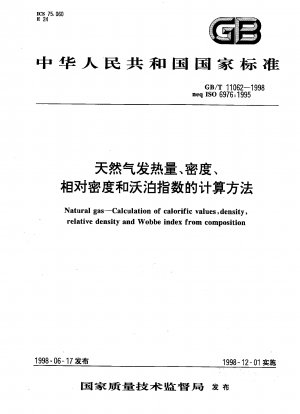GB/T 11062-1998
Natural gas--Calculation of calorific values, density, relative density and Wobbe index from composition (English Version)
- Standard No.
- GB/T 11062-1998
- Language
- Chinese, Available in English version
- Release Date
- 1998
- Published By
- General Administration of Quality Supervision, Inspection and Quarantine of the People‘s Republic of China
- Status
- 2015-05
- Replace By
- GB/T 11062-2014
- Latest
- GB/T 11062-2020
- Scope
- This standard specifies the methods for calculating the high calorific value, low calorific value, density, relative density and Wobbe index of dry natural gas, natural gas substitutes and other gaseous fuels when the gas composition expressed in mole fraction is known. The method also gives an estimate of the precision of the calculated physical property values. Calculations for properties on a molar or mass basis apply to any dry natural gas, natural gas substitutes, and other fuels that are generally in the gaseous state. For the calculation of physical properties based on volume, this method is limited to gases with a methane mole fraction of not less than 0.5 in the composition. Tables 1 to 5 of this standard give the basic physical property values required for calculation, and Appendix A gives the values of auxiliary constants used in the calculation. NOTE 1 If the gas composition is given in volume fraction, it should be converted to mole fraction (see Appendix B). However, it is worth noting that the uncertainty of the converted mole fraction will be greater than the uncertainty of the original volume fraction. 2 As far as this standard is concerned, the mole fractions of each component used for summing should be unified to the fourth decimal place (0.0001), and all components with mole fractions greater than 0.00005 should be taken into consideration. 3 For the calculated volumetric calorific value, there are also restrictions on the content of other possible components except methane. Generally, the mole fraction of N2 should not exceed 0.3; the mole fraction of CO2 and C2H should not exceed 0.15; the mole fraction of other components should not exceed 0.05. 4 The effect of water vapor on calorific value, either directly measured or calculated, is discussed in Appendix C. 5 For the calculation method described to be valid, the gas must be above its hydrocarbon dew point at the reference conditions described
GB/T 11062-1998 history
- 2020 GB/T 11062-2020 Natural gas—Calculation of calorific values, density, relative density and Wobbe indices from composition
- 2014 GB/T 11062-2014 Natural gas.Calculation of calorific values, density, relative density and Wobbe index
- 1998 GB/T 11062-1998 Natural gas--Calculation of calorific values, density, relative density and Wobbe index from composition
